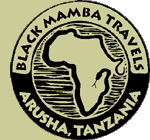

|
|
|
||||||
|
|
|||||||
|
|
|||||||
|
|
Black Mamba Travels LtdP.O. Box 2674 Arusha, Tanzania. Tel: 255 27 0748 319740 |
In addition to the eight parks of the northern and southern circuits, Tanzania has four other more remote national parks to explore. Gombe stream, Katavi and Mahale mountains, in the west, and Rubondo Island in Lake Victoria. Gombe Stream National Park A mountainous strip that borders the shores of Lake Tanganyika, about 16km from Kigoma. Gombe Stream offers visitors the rare chance to observe the chimpanzee communities made famous by British explorer Jane Goodall. A number of monkey species can also be seen including red colobus, red-tail and blue monkeys. The area is heavily forested making it an unsuitable habitat for carnivores and safe for walking safaris. Birdwatchers will be richly rewarded. Katavi National Park The main features of Tanzania's third largest park, located about 40km south-east of the town of Mpanda, are Lake Katavi, with its vast floodplains, the palm fringed Lake Chala and the Katuma River. The park is noted for its Miombo woodland and home to buffalo, elephant, leopard, lion and zebra. Antelope species include eland, impala, topi, roan and sable. Water fowl are abundant with Lake Chala particularly rich in bird life with over 400 species recorded. Katavi also boasts Tanzania's greatest concentration of hippo and crocodile. Mahale mountain National Park The other sanctuary of the chimpanzee, Mahale Mountains National Park, is also reached by boat from Kigoma. Covering an area of approximately 1,000 sq km, the park's western boundary is the shore of Lake Tanganyika. The chimpanzee population is estimated at around 1,000 and they may be observed in their natural habitat in groups of up to 30. Baboons and colobus monkeys also live in the park while other animals found there include buffalo, bush pig, elephant, giraffe, leopard, lion, porcupine and various types of antelope. Lake Tanganyika is home to more than 250 different species of fish. Rubondo Island National Park A water wonderful comprising Rubondo Island and nine smaller islands tucked into a corner of Lake Victoria north-west of Mwanza. The park provides a variety of habitats ranging from savannah to open woodland, dense forest, papyrus swamps and sandy beaches. There is also a wide variety of animals including bushbuck, crocodile, elephant, genet, giraffe, hippo mongoose vervet monkey and the reclusive sitatunga-a shaggy aquatic antelope. The bird life is unique with birds from east, central and southern Africa flocking to bird island to breed. Bee-eaters, fish eagle, ibis, kingfisher and saddle-billed stork will be seen while tilapia and Nile perch abound in the lake. Other Places to See In addition to the fantastic wildlife and stunning scenery there are plenty of other things to see in Tanzania. Amboni Caves About 8km north of Tanga these ten limestone caves, formed during the Jurassic Age some 150 million years ago, are the most extensive cave system in East Africa. Isimila Stone age Site About 20km south of Iringa, on the main road to Mbeya, some of the richest finds of Stone Age tools were discovered in 1951. Many fossilized bones were also found in the area, among those of a mammal related to the modern giraffe, but having a much shorter neck, and an extinct hippopotamus with unusual periscope-like projections. Kalambo Falls. Close to the border with Zambia and near the tip of Lake Tanganyika, a 215 metre drop makes this one of the highest waterfalls in the world and, after Tugela Falls in South Africa, the second highest in Africa. A breeding ground of the giant marabou stock, primitive tools have been excavated from Kalambo Gorge. Kondoa Irangi Rock Paintings Half way between Dodoma and Arusha, near the village of Kolo, are some of the finest examples of rock paintings in the world ! These extraordinary paintings depict the animals and customs of the people at the time. Lake Natron A soda lake, on the border with Kenya 200km north west of Arusha, which is home to thousands of flamingo. Lake Tanganyika The water of Lake Tanganyika, the longest and after Lake Baikal in Siberia, second deepest freshwater lake in the world contain one of the richest concentration of fish found anywhere. More than 250 different species live within it. Lake Victoria The source of the Nile eluded 19th century explorers but today's tourists can easily view the waters that supply it. Lake Victoria is the largest lake in Africa and, after Lake Superior in North America, the second largest freshwater lake in the world. Mbozi Meteorite A 15 ton iron monolith, discovered in 1942, which can be viewed near Mbeya on the road to Tunduma. It is the third largest meteorite ever found. Mkomazi Game Reserve Containing 90% of all botanic species found in Tanzania with one third classified as unique in the world. The reserve is also home to the Mkomazi Rhino Project. This involves the re-introduction of four black rhino from South Africa which , it is hoped, will breed before being relocated to traditional natural habitats with Tanzania. Mwanza Tanzania's third largest town and the main base for exploring Lake Victoria. The Bujora Sukuma Museum, and Saa Nane Island bird Sanctuary are nearby. Oldonyo Le' ngai Located at the southern end of Lake Natron, this is the only active volcano in Tanzania. It last erupted in 1966. Known as 'Mountain of God' to the Masai, it rises to an elevation of 9,442 feet. Tenduguru A site near Lindi, where the remains of a complete dinosaur were found in 1912. Ujiji A village, ten miles from Kigoma where Henry Morton Stanley pronounced the famous words 'Dr. Livingstone I presume'. |